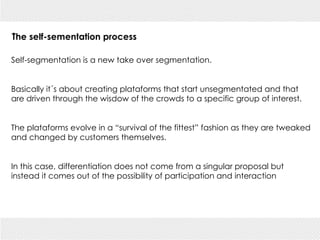endossa - Self-Segmentation in the retail industry
- 1. Self-segmentation in the retai industry. A case from www.endossa.com
- 2. What is segmentation? Segmentation is the process by which companies arrange markets, and thus customers in clusters. These clusters may come in many varieties, being defined by age, gender, interests, location etc. Modern segments are more sophisticated, combining several characteristics. The urge to segment markets is oftenly attributed to competition. The claim is that without segmentation, a product or service lacks focus, identity and tend to not have any kind of differential.
- 3. The traditional process of segmentation Segmentation is normally seen as something a company does to a market all by itself. It requires accumulating data and then sorting through it. Traditionally, an innovative segmentation involves data only one person has, or at least a way of framing the market nobody else has pursued. Altough customer feedbacks are oftenly used as inputs to the segmentation process, they are not involved in it. Customers are seen as targets, not as partners.
- 4. The problem starts here It is a fact that currently, consumers are more marketing-savvy than they ever were before. It´s also a fact that this savviness is increasing exponentially. Also, there are several forces acting upon the market today that demand radical transparency, and even more importantly consumer empowerment. So why not try and build a model of segmentation that is driven for and by customers instead of being targeted at them?
- 5. 1 The self-sementation process Self-segmentation is a new take over segmentation. Basically it´s about creating plataforms that start unsegmentated and that are driven through the wisdow of the crowds to a specific group of interest. The plataforms evolve in a “survival of the fittest” fashion as they are tweaked and changed by customers themselves. In this case, differentiation does not come from a singular proposal but instead it comes out of the possibility of participation and interaction
- 6. Let´s illustrate with a retail example. Endossa / loja colaborativa is a retail self-segmentating example. The store operates in a manner that resembles consignation, but with twists. It does not charge vendors comissions. Instead it charges a fixed rent for shelf-space. Because of this, the vendors take all the risk concerning the potential sales of their products. The store is a plataform for sales, and as a plataform it´s free to play with self-segmentation.
- 7. The mechanisms behind endossa – Part 1 Since none of the sales risk is deposited on the shop, endossa exerces no influence over it´s on product mix. This means it does NOT select vendors. Spaces are rented to anyone, independently of their products. This, of course, means no proprietary filtering is made, thus the store begins unsegmentated. Things start to change thanks to the “Every Purchase is an endorsement” mechanism.
- 8. The mechanisms behind endossa The mechanisms behind endossa – Part 2 “ Every Purchase is na Endorsement” is a simple algorithm that compares revenues generated by a vendor with the price of the rented space. If a vendor can´t sell over its target-revenue for three consecutive periods, it won´t be allowed to rent a space in the upcoming period. This makes customers the curators of the store, since over time, only the best sold brands are allowed to stay.
- 9. Why is this self-segmentation? “ Every Purchase is na Endorsement” allows consumers to level the product mix of the store to their needs and wants. In other words, the store aggregates knowledge of what they are interested at, by a simple process of counting every sale as a vote. On every iteration of the algorithm, the store becomes more and more close to its audience. And what´s best, since they are driving the process if they change, the store changes too.
- 10. But wouldn´t that happen anyway? One can argue that every store cuts products that don´t sell enough. They would be right, but they should also consider this: 1 – At endossa, the mechanism that rules the community is more transparent and impartial. No one is driving it alone and so it tends to be more democratic, even anarchic in a sense (a great sense, tough). 2 – The fact that no one is deciding which vendors come to the store is also very relevant. Every one starts with equal oportunities and the products that are put to the test aren´t subject to bias and myopia.
- 11. The end has no end... There are several of other examples of self-segmentation in action. Mostly in the web (Amazon.com and it´s collaborative filtering mechanisms come to mind...) But it´s always nice to see how this can be applied to a traditional industry, by a traditional bricks-and-mortar store.
- 12. Why isn´t WAL MART TM afraid?












